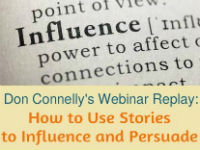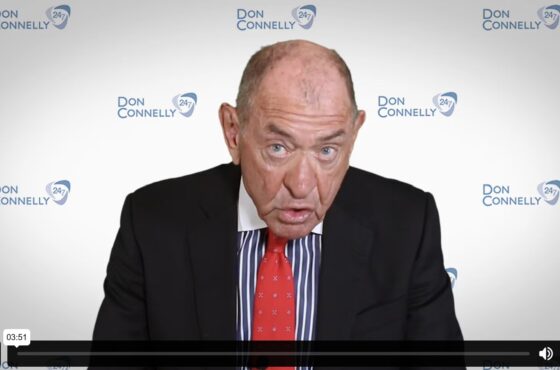5 Simple Stories Any Financial Professional Can Use
 It’s a proven fact that stories can influence the way we think, our decisions and how we feel, when used in personal or professional communications.24
It’s a proven fact that stories can influence the way we think, our decisions and how we feel, when used in personal or professional communications.24
► A storytelling 2-CD set, Say It So It Makes a Difference, is now available in the store.
Speaking of Financial Services in particular, we know that it is a relationship building business. As stated by Don Connelly on many occasions, before someone will do business with you there are three things that must take place in the relationship: “That person must like you, trust you and think you are smart.” – Don Connelly.
Effective storytelling is a great tool by which Financial Advisors can instantly establish a personal connection with their prospects because:
- People love word pictures and are better able to understand concepts more clearly with a good word picture. Financial jargon can be confusing and data can be overwhelming. Stories simplify the message.
- As humans we are naturally interested in doing business with people we know. Telling a ‘who I am’ story or sharing a personal experience that resonates with your prospect’s situation is one of the best ways to start strengthening the bond.
To become a good storyteller is a three-step process –
1) You must create good stories. 2) You must practice them until they become second nature. 3) You must tell them with passion.
There are multiple posts and training materials by Don Connelly on how to create good stories. For the purpose of this post, I have collated some short and ready to use stories, from Don’s inventory and others, that financial professionals can use effectively to strike a chord with their prospects, clients or sales teams:
#1. The Gretzky Story:
As we know, clients are lured by short term performance. They are interested in finding the latest, hottest, top performing investments. It becomes difficult to explain to clients and prospects that people who buy those top performing investments today may not necessarily enjoy the same returns in the future. Although you may be familiar with the “The Gretzky Story” it is still a simple yet powerful story to use with clients who say “I wanna buy what’s hot”. Here’s the summary:
Years ago, a hockey game between the Boston Bruins and Edmonton Oilers had been paused for some technical issues with the stadium lights. To kill some time, the announcers started interviewing people including the Edmonton Oilers, Wayne Gretzky, undoubtedly the world’s greatest hockey player at the time. The announcer stated that Gretzky wasn’t the biggest guy in the league, or the strongest, or the fastest or the toughest, yet he was regarded as the greatest hockey player in the world. So, how then did Gretzky explain his own genius? Gretzky simply replied:
“I don’t go where the puck is; I go where the puck is going to be!”
In a simple one liner, Gretzky confirmed that his success did not come from chasing the puck. Instead it came from staying one step ahead and by anticipating where the puck would likely go next.
Use this powerful story to explain to your clients why it is important to look at the future potential of an investment instead of focusing on past performance.
Listen to the full story below:
#2. The Window Salesman
“You must learn the requisite selling skills. Because if you don’t have an appointment, you don’t need a product or product knowledge.” – Don Connelly.
Just like storytelling, learning effective sales skills are paramount for success. Let’s take a look at how storytelling can help improve sales skills.
Amidst all the sales jazz like low prices, features and benefits, salespeople and Advisors often forget or ignore the importance of politeness, courtesy, good manners and attitude in the selling process. Many times, deals don’t close and accounts aren’t opened simply because the client just didn’t like them!
Gary Hanley wrote a great story that’s just perfect to explain the importance of good manners and being likeable to achieve success in sales.
The story is about a newbie window salesman named Terry from England, who was so terrible at selling that he could not even convince his own family to buy from him. It goes like this:
“Terry’s boss decides to send him out on a practical field trip on his first day. He throws him right into the deep end by asking him to visit an interested prospect at the posh end of town… where the big money is in Windows/Double-glazing sales. So off he goes.
He was extremely nervous. With his hands shaking and his knees knobbing, he approaches the front door and thuds the door knocker several times. An old woman approaches and, after his first shaking introduction, she invites him in.
He stays there for over 3 hours. Then, after dozens of cups of tea and mounds of biscuits, the woman signs a contract and purchases over £7000 worth of windows (that’s over $11,000 in U.S. dollars!)
And, here’s The REAL Kicker – The woman had already spoken with 6 other dynamite glazing salesmen that week. ALL of them offered her a cheaper quote! That’s right – Terry’s price was the MOST expensive. He was also the most inexperienced salesman..”
So, what happened in the background? And moreover, how can you replicate these powerful sales techniques to step up a notch on your own profit ladder? Here comes the secret.
The woman said, “She LIKED the young lad more than the others.”
Surprising isn’t it!
Use this story at one of your sales meetings to explain how politeness and likeability can become deal makers.
To read in full, check it out at Willetta Pilcher’s blog – The Seed Sower.
#3. The Six Blind Men and The Elephant
 This story first originated in the Indian subcontinent but gained worldwide popularity after John Godfrey Saxe, an American poet, created his own version as a poem. Since then, the story has been used in various situations and is interpreted in a variety of ways to highlight the need for communication, expert opinion, and respect for different perspectives.
This story first originated in the Indian subcontinent but gained worldwide popularity after John Godfrey Saxe, an American poet, created his own version as a poem. Since then, the story has been used in various situations and is interpreted in a variety of ways to highlight the need for communication, expert opinion, and respect for different perspectives.
Here’s how it goes:
“Once, 6 blind men are asked to describe an elephant. The first one touches the side and describes the elephant like a wall. The second one touches the tusk and calls it a spear. The third one touches the trunk and describes it as a snake. The forth one touches the knee and calls it a tree. The fifth one touches the ear and says it’s a fan. Finally the last one touches the tail and describes the Elephant as a Rope!“
None of them called an Elephant an Elephant. Do you know why? Because their perceptions lead to the misinterpretation. They all describe the elephant differently, just on the basis of the part of the elephant they touched.
Let’s see how this relates to stock markets and investors.
Consider the stock market as the elephant while investors or participants in the stock market as the blind men.
Often investors see their portfolio’s performance or the Stock Markets from the current / recent results perspective. This leads to incorrect interpretations. This situation is termed ‘Recency Bias or The Party Effect’. Don explains it with this example –
When you are driving alone and you see a speed trap – you slow down. However after you’ve passed it, you continue to drive slowly because you think there is another one out there. Similarly, people panic when their portfolio goes down and they think it will continue to do so. They feel excited when their portfolio goes up and they think it will continue to go up. What they forget is that their goal is long term. Markets go up and down every day! The current performance of the market does not alter their goal to retire comfortably 20 years down the line.
A few ideas how this story can be used :
- To explain to clients that most investments do not generally offer steady returns. They change every single day.
- To explain to clients the importance of utilizing a Financial Advisor to help analyze things from a broader perspective and to help guide them toward making better decisions.
- To explain how the current behavior of the stock market should not cause clients to deviate from their long term investment goals.
To read the full story, check out this post at wikinvest.com .
#4. Tony’s speech
These days, competition is at its peak. Running a Financial Advisory business is not easy. It’s imperative that Advisors and their Sales teams provide not just good, but exceptional services. Tony’s speech is a story that I came across at Mindtools.com, and found it quite motivating. It illustrates the importance of Team Work in building success.
The story is about an Entrepreneur (fictitious), Tony whose company just had the worst third quarter in its history. So at the annual town hall meeting, he gives a speech to boost his team members’ morale, hoping they would get inspired to work harder and make up for the losses in the next quarter. The speech goes like this:
“When I started this company 10 years ago,” he begins, “I didn’t know how to run a business. I figured I could do everything myself and succeed.”
“I was dead wrong. I worked 15-hour days to keep up with it all. I wanted to grow the company, but I quickly realized that I didn’t know how, and I couldn’t do it alone.”
Tony continues, “All of you know how stubborn I am, so I tried to go it alone. But I started to lose clients because I couldn’t keep my promises. I didn’t have time to bid for work, so my competitors got ahead, and I lost even more clients. This put enormous pressure on my family because I was never home. I knew that if things continued this way, the company would go under in a matter of months, and that I might lose my family. I needed help.”
“Once I realized I had to ask for help, I did. I put some major projects on hold, and started to look for great people to help me. I handpicked each of you because you’re the best at what you do. You have the skills, knowledge, and experience that I lacked.”
“This company is the success it is because of all of you. Every company has its ups and downs, just like I did when I first started this business. But I believe in all of you, and I believe that we will turn this problem around next month. So, let’s focus on the future, and think about how we can help one-another succeed.”
Quite Inspiring! When I first read this story, I could instantly relate to so many things Tony said to his team as if those were my own experiences. I decided to include it in this post considering many of us have real life experiences similar to the one’s Tony shared.
Financial Advisors can take ideas from this story to craft their own real life story and can use it with their own sales team or Advisory group to:
- Motivate them to overcome a sales slump, or
- Explain the importance of working in teams.
#5. The Greatest Equity Story Ever Told
 People always look for reasons to not Invest.
People always look for reasons to not Invest.
“I can’t invest because”. . . :
I just bought a new car…planned a vacation…
9/11 just happened… stock markets just crashed…
No matter how many excuses one comes up with – be it personal, political or financial, it often boils down to an incorrect perception about what it takes to be a successful investor.
As a Financial Advisor, it’s your job to help prospects overcome this fear of investing by making them understand that they need more than just their saving accounts to retire comfortably.
You’ve got to motivate people to take action for their own benefit!
Don’s story, titled “The greatest Equity story ever told” is a powerful narrative to make people understand the importance of Equity Investing. The story addresses the following:
- Explains how risk tolerance, risk perception and recency bias influence Investor decisions.
- Explains how WE can help clients make better decisions by illustrating the market’s long term success in the face of continuing economic and political turmoil and natural disasters.
To summarize, “the greatest equity story” is a snapshot of how the US stock market has been impacted in the last 60+ years.
Don iterates events like the Korean war, Kennedy’s Assassination, Recessions, Inflations, Hurricanes, 9/11, Subprime Lending, etc., all which caused or could have caused major setbacks to the market. He explains how people develop strong negative perceptions about investing and instead, allow short term incidents to overrule their ability to think long term. In short, they ignore the long term market performance.
In 1950 the Dow was at 198.89. Today, in 2014, it’s at 16512.89. That’s about an 83 times increase!
Listen to the preview of the story on our You Tube channel and learn to narrate it with the same passion as Don does in the video. It’s a surefire way to get your prospects to act and focus on their long term goals.
You can purchase the full webinar “The Greatest Equity Story Ever Told” at the store.
Stories and word pictures are inspiring and easy to remember. Most importantly they help create a connection which is vital for establishing and strengthening the Client-Advisor relationship.
Ira glass said, “Great stories happen to people who can tell them”.
There are various types of stories that financial professionals can use based on their objective, their audience or their desired outcome.
Following are some examples:
- Stories to help middle aged couples overcome the fear of losing money by Investing.
- Stories to motivate millennials to start investing early and saving for retirement.
- Stories to educate parents about the benefits of college savings plans.
- Stories to motivate sales teams to achieve success.
- Introduction stories, Success stories and so on…
Having said this, do you agree that “Good Storytelling” breeds greater success in business?
See how Don can help you with your storytelling skills!
 |
 |
 |
As always, I would love to hear your thoughts. Also, if you would like to share some short stories that have worked wonders for you, do share them in the comments.





Thanks for using the story “The Window Salesman” I’m sorry the spam detector wouldn’t allow you post a comment but thanks for the referral. We have to keep the spam at a minimum because there are lots of crazies out there. 🙂 And some just want to use your space as advertising for their product.
Hey Willetta,
Thank you for appreciating. Glad you liked it.Totally understand your concerns about the spam comments – we have something in common. 😉 haha.. By the way, I couldn’t find you on social media. Do you have a Twitter / Linked In Profile? If yes, may be we can connect over there.
– KAS
Hi Don. Do you have a good story I can use for a client that thinks he wants to use 2 advisors to “diversify” his advice?
Thanks,
Norris
Hi Norris, Don has a good analogy when convincing someone he or she should have all their assets with the same advisor – that money is like a puzzle. Check out this post (it’s audio but there’s also a transcript if you prefer to read).
Hope this helps and thanks for reading Don’s blog!
~Diana